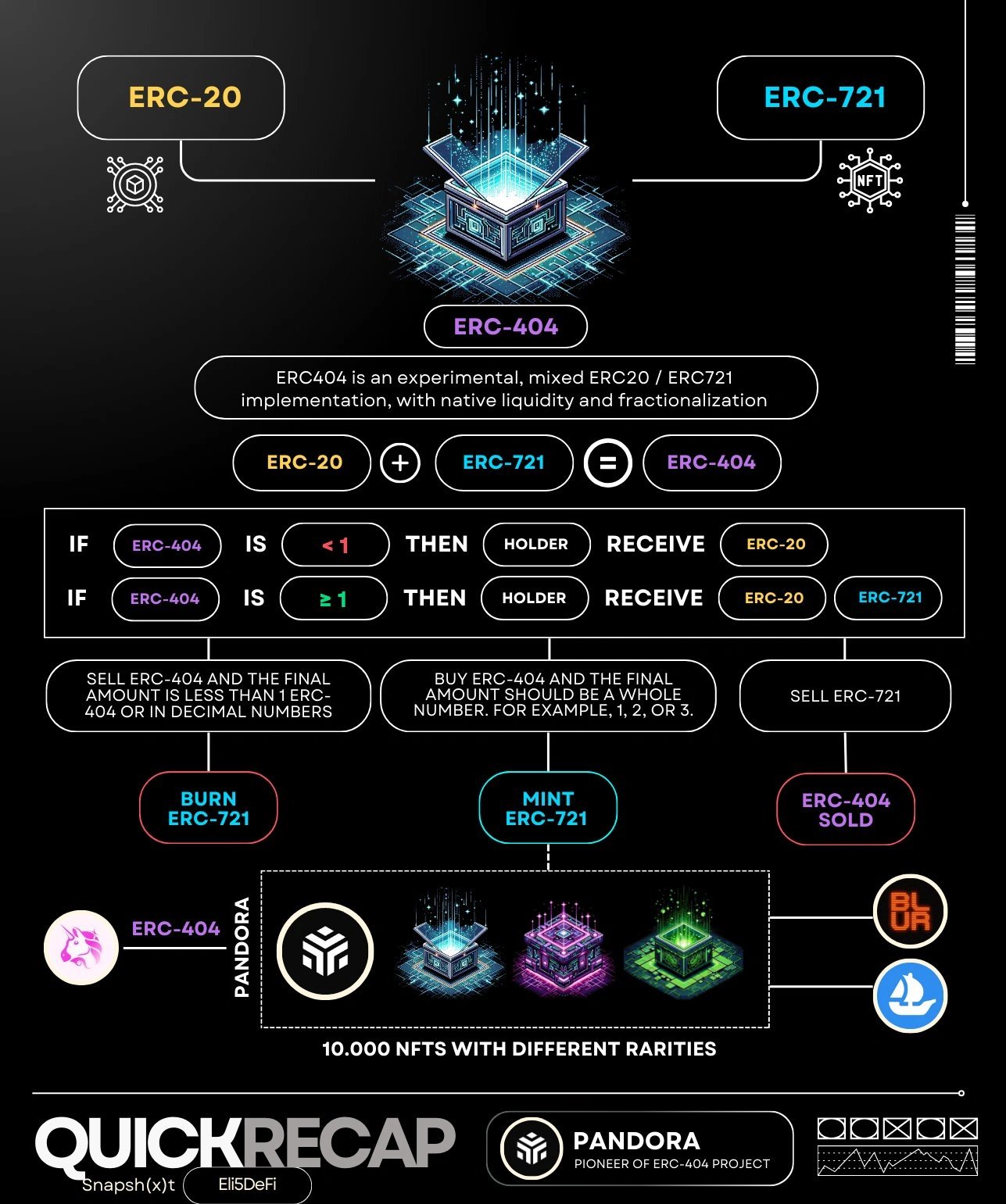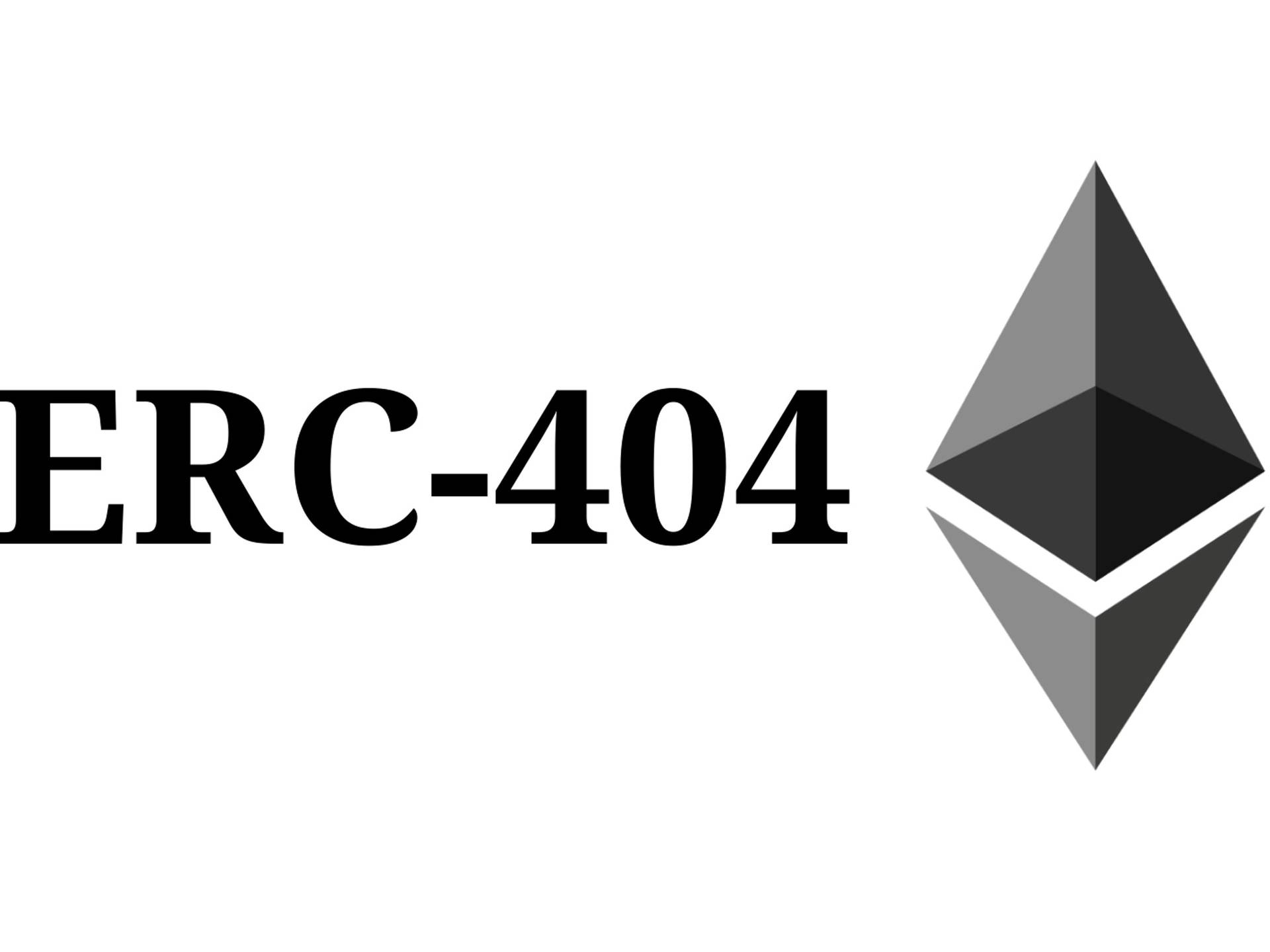订阅 wiki
Share wiki
Bookmark
ERC-404
ERC-404
ERC-404 是一种构建在 以太坊 区块链上的实验性代币标准。ERC-404 旨在将 ERC-20 代币(同质化代币)和 ERC-721 代币(非同质化代币,或 NFT)的功能整合到一个标准中。[4]
截至 2024 年 2 月,ERC-404 尚未被正式认可为 以太坊 代币标准。它目前正处于开发中,尚未被正式提议为官方的 以太坊改进提案 (EIP)。然而,一些项目已经采用了该标准,展示了其潜力。[8][9][10]
概述
一个非官方和实验性的 以太坊 标准,被称为 ERC-404,旨在成为同质化和 非同质化代币 (NFT) 的混合体。该标准由化名为 “ctrl” 和 “Acme” 的开发者在一个名为 Pandora 的项目下创建,它将 ERC-20 同质化代币背后的技术与 ERC-721 非同质化代币 (NFT) 相结合。[3]

Pandora 成为第一个 ERC-404 代币,总供应量为 10,000 个,于 2024 年 2 月 2 日推出。在 ERC-404 不是官方代币标准的情况下,Pandora 在四天内获得了超过 1,850% 的收益,市值接近 2.93 亿美元。2024 年 2 月 6 日,Pandora 过渡到 2/4 多重签名。[3][6]
当有人购买 1 个 Pandora 代币时,他们会获得该代币以及与该代币相关的 “复制品” NFT。NFT 会自动铸造到他们的钱包中,并具有随机特征。如果他们最终喜欢他们的 NFT,他们可以保留它。或者,如果他们最终获得了稀有特征,他们可以通过 NFT 市场出售。如果他们不喜欢/不想要 NFT,他们可以出售 Pandora 代币。当他们出售代币时,与之关联的 NFT 会被销毁。
NFT 是独一无二且不可分割的,没有人可以拥有 NFT 的一部分。ERC-404 通过使用代币 铸造 和 销毁 机制来规避此限制,从而实现 NFT 的部分转移。发行的代币与 NFT 相关联。如果有人购买了完整的代币,则链接的 NFT 会被铸造到他们的钱包中。如果出售了代币的一部分,则链接的 NFT 会被销毁。如果持有代币一部分的钱包购买了足够的部分以持有完整的代币,则会自动铸造一个新的 NFT。
ERC-404 旨在将 ERC-721 NFT 绑定到 ERC-20 代币,从而实现一些人所描述的碎片化 NFT,允许多个钱包各自拥有一部分 NFT,并使用该部分进行交易或质押以获取贷款。
虽然碎片化 NFT 确实存在,但它们通常依赖于一个实体,该实体将这些 NFT 锁定在一个钱包中,并发行代表该 NFT 的代币。这些碎片化代币可以自由交易,并且可能无法准确匹配锁定的 NFT 的价值。这是 ERC-404 旨在解决的关键问题之一。它允许多个钱包直接拥有一个 NFT,并且在未来,可以创建一个用例,其中该特定风险可以被代币化,并用于提取贷款或质押持有。[2]
Pandora 和 ERC-404 的开发者之一 ctrl 说:
“加密货币领域的人们讨厌摩擦。在 ERC-404 之前,每个解决方案都有太多的摩擦,并且通常是一个包装解决方案,它抽象了人们想要碎片化或使其具有流动性的原始 NFT,”
ERC-404 不是官方认可的 以太坊 代币标准。该团队正在积极制定 以太坊改进提案 (EIP)。
如果获得批准,该标准将成为以太坊基金会(一个维护以太坊区块链的非营利组织)认可的 “官方” 标准,用于以太坊生态系统中,作为与基于以太坊的应用程序兼容的商定框架。[2]
ERC-404 的主要特点
- 部分所有权 ERC-404 引入了部分所有权这一革命性的概念,允许投资者拥有非同质化代币 (NFT) 的一部分。此功能使访问高价值数字资产民主化,从而使更多人参与 NFT 市场。
- 代币铸造和销毁 ERC-404 的代币铸造和销毁机制对于促进部分所有权至关重要。当购买完整的代币(代表 NFT 的完整所有权)时,相应的 NFT 会被铸造到买方的钱包中。相反,当出售代币的一部分时,链接的 NFT 会被销毁,从而确保所有权记录的完整性。
- 增强的流动性和交易 通过启用部分所有权,ERC-404 增强了 NFT 市场的流动性。投资者可以交易 NFT 的一部分,而无需完全所有权,从而提高市场效率并降低小型投资者进入的门槛。这种增强的流动性还促进了围绕 NFT 开发新的交易策略和金融产品。
利用 ERC-404 的平台
- Pandora 作为利用 ERC-404 的先驱项目之一,Pandora 利用该标准创建具有原生碎片化的 NFT。这不仅增强了流动性,还在 Pandora 生态系统中实现了创新的交易策略,例如 收益耕作 和 流动性挖矿。
- DeFrogs DeFrogs 是一个使用 ERC-404 的 PFP(个人资料图片)集合。DeFrogs 展示了 ERC-404 在引入通货紧缩 NFT 集合方面的潜力。通过将 ERC-404 与独特的经济模型相结合,DeFrogs 创造了稀缺性并鼓励其 NFT 的价值升值,从而吸引了收藏家和投资者。
- Monkees Monkees 项目探索了 ERC-404 的各种应用,尤其是在各种数字资产类别中的部分所有权。通过对艺术品、房地产和知识产权等资产进行代币化,Monkees 展示了 ERC-404 在传统 NFT 之外的多功能性。
- 游戏 NFT ERC-404 通过创建具有随机属性和特征的游戏 NFT,彻底改变了游戏行业。这些动态 NFT 为玩家提供了独特的游戏体验和经济激励,例如游戏内奖励和跨不同游戏平台的资产互操作性。
发现错误了吗?
